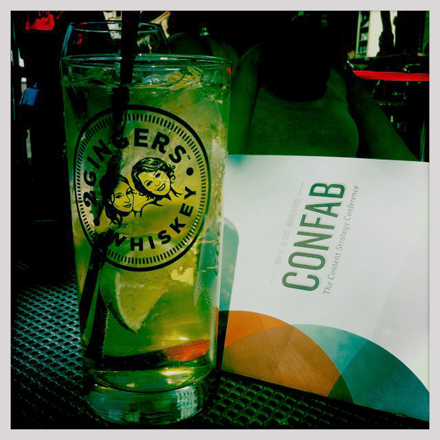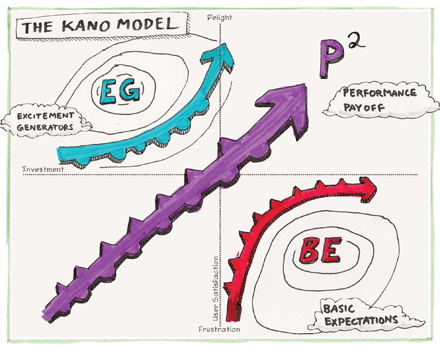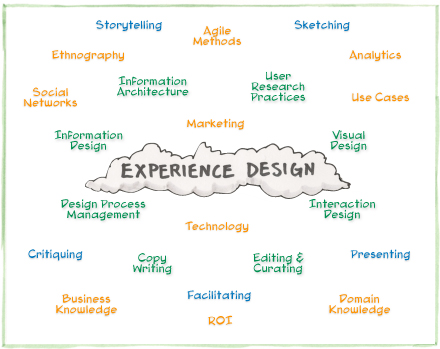Confab mashup: tips for SEO, user experience and content strategy
 Confab is “the content strategy conference,” put on annually by Brain Traffic in Minneapolis. Their 2011 conference was a tough act to follow, but this year’s gathering did not disappoint. The following is a download of some of my takeaways.
Confab is “the content strategy conference,” put on annually by Brain Traffic in Minneapolis. Their 2011 conference was a tough act to follow, but this year’s gathering did not disappoint. The following is a download of some of my takeaways.
Speak in pictures.
Dan Roam’s keynote kicked off the conference with something the graphic design world has known for decades: “To make content memorable, make it visual.” He referenced the book Moonwalking with Einstein, which examines how memory works — the gist being that the human brain turns ideas, words, stories, etc. into pictures in order to remember them. Our minds can parce and process dozens of images in the same time it takes us to read and process a single sentence. We will also remember those images more accurately and for longer than the sentence.
He posits that all “vivid ideas” — those that we quickly understand and that stick with us — have the following characteristics (which we can remember using his acronym FOREST):
- Form — Make your idea specific and tangible, not abstract.
- Only Essentials (or BLUF – bottom line up front) — Don’t hinder the idea with unnecessary information; get to the point.
- Recognizable — Make sure the tangible form you’re using is a familiar one. It will be easy to remember and connect with. For example, the top dozen business books sold in the last decade all use visual metaphors as titles: Blue Ocean Strategy, Purple Cow, The Tipping Point, Linchpin. None of these have technical, literal titles; they all use images packed with meaning.
- Evolving — A vivid idea has room within it for your audience to add to it, evolve it through their own experiences.
- Spans Differences — This one is a little difficult to explain. Dan used this example: Car makers start with the choice between power and efficiency; a car can’t have both. So to come up with a great idea that achieves both, look at the thing that’s forcing it to be one or the other. Tesla Motors spanned the power-efficiency divide by replacing the internal combustion engine, the hindrance, with an electric one. I think the point is this: challenge the thing that makes innovation impossible and therein lies your great idea.
- Targeted — A vivid idea is one that considers its audience. Align it to the needs and style of the people you’re trying to reach.
My conference buddy, Christa Bianchi, suggested that “targeted” should be where we start, not where we end. And I’ll add that “spans differences” should follow. The rest are just refinements.
While I find Dan’s mnemonic rather forced and disjointed, its essence is a good general checklist that we marketers can use when developing a new campaign, website or product concept. To learn more about Dan’s vivid thinking, check out his new book, Blah Blah Blah. It’s really fun to read…because it’s full of pictures.
User experience (UX) should drive every project.
With the best visuals of the conference (below), Jared Spool’s “Mobile & UX” session was a LOL good time; it was also really informative. For years, he posits, market maturation has followed this path: Technology > Features > Experience. That is, innovation takes place in the tools and machines first. Once we reach our limit there and the existing hardware becomes more affordable, then companies pay attention to the features — what can we make this hardware do. Then when they’ve maxed out features, they move on to user experience — how can we make the user’s interaction with this hardware and these features better. Any designer (industrial, graphic, web, content) knows that this process is backward.
For a more successful [website, app, widget, brand, event], begin the process with user experience. The Kano Model is where to start. Basic functionality alone is not going to make your investment pay off. Rather, you need to add elements of delight. But beware: Over time, delighters become basic functionality, so you have to keep giving users more. (We used to be delighted when our [hotel, coffee shop, airplane] had WiFi. Now we’re annoyed if it doesn’t.)
With technology advancing, features abounding, and users becoming more and more demanding, experience designers have to truly be a jack of all trades. Or, rather, experiences need to be created by teams so that each of these skills is available:
Experience Designers have to have many skills:
(One of the great things that happens at these conferences is validation. Thinkso has always focused on being multidisciplinary. We do work across just about every platform and in every industry. Everyone on our staff is armed with multiple skills. Our interactive design director has a degree in philosophy and is a kick-ass illustrator. Our marketing strategist is also a photographer with a degree in creative writing. I can confidently state that the Thinkso staff covers every skillset in the graphic above.)
Site search analytics is a virtual hotline between your company and its users.
Another great thing about these conferences is that we get taught by industry superheroes. Lou Rosenfeld is the author of Information Architecture (the big book with the polar bear on the front, the bible for IA). His session focused on site search analytics (SSA). This refers to the data around the words that users on your site put into your search field (not what people are searching for on Google). SSA is not automatically set up in your Google Analytics, but it can be turned on.
Looking carefully at what keywords users are searching for on your site — and on what page they are entering these terms — will tell you a lot about what your audiences want, what nomenclature they are using, and what information might be on your site but they aren’t finding. Mapping SSA by time can help you determine the seasonality of certain keywords — what audiences are interested at certain times of the year. Then you can switch up messaging accordingly.
Another cool tip: If your organization’s jargon (e.g., program or product names) are low in the SSA, don’t spend money on name awareness. Just make sure you use the language users are using on those program pages.
Organic search is still more important than social media.
Melanie Phung, Director of New Media for PBS, shared her search engine optimization (SEO) best practices with us.
Organic search makes up 40% of most site’s traffic. What’s more, hits generated through organic search are of higher quality than those generated through social media. (Higher quality = stay on your site longer, visit more pages, take action.)
Despite what many experts believe, search ranking is very important because 90% of clicks happen on the first search results page and the first result gets 50% of those clicks.
SEO is not about making content for machines. It’s about making sure machines understand your content so that they give you the visibility you deserve. What search engines care about:
- Words. Visuals are great on your site, but be sure to contextualize them with text on your page so the engines can find the content in the video.
- The brand/reputation/design of your site. (Yes, search engines now measure how “authoritative” your site is through how well its put together, written and designed.)
- Social media shares/inbound links. Get others to link to your site.
Google Webmaster Tools will analyze the SEO effectiveness of your site.
Search engines are treasure troves of audience data.
Another industry superstar, James Mathewson from IBM, continued the SEO discussion. The gist of his presentation: Keyword research helps us reduce jargon and improve customer delight.
He gave us a few more insights into what search engines care about, in particular what Google’s Panda and Penguin look at:
- It’s important to have real content above the fold. Not just pictures or, gawd forbid, ads.
- The algorithms look at your whole web environment rather than one page at a time. So the quality of your site overall is more important than having one or two really good pages.
- The semantic relationship between two words is very important to these modern algos. In other words, your content needs to be well written. Repeating the same keyword from sentence to sentence does not make for well written copy; therefore, it will hurt your SEO, not help it.
- Marketers beware: Google uses spaces between words to parse language. When you put words together, they are gibberish to Google.
- Don’t use corporate jargon! Instead, find out what terms (keywords) your audience uses and use those.
Content should be your primary “platform.”
Karen McGrane closed out Confab with an entertaining, informative (and irreverent) look at the publishing world, structured content, and content distribution strategies. She’s another verifiable superstar in this biz (which she clearly knows) and her presentations never disappoint.
She gave us a review of how the news media (Condé Nast, New York Times, NPR, Boston Globe, The Guardian) are handling platform fragmentation (and by that I mean: we’re digesting media on so many different devices and through so many formats). NPR’s approach is the clear winner: Create Once, Publish Everywhere (COPE). Over the last year, NPR’s total page view growth has increased by more than 80%.
Why are the news organizations the innovators? Because they already have what we in the web world call structured content. Journalists automatically write in chunks: hed, dek, lede, captions, cutline, nut graf. This structured content is adaptive content. It can be easily pushed out through various channels. It’s presentation independent. When writing content this way, you automatically have what you need to communicate on a long-form web page, in print, on a mobile site, through Twitter.
The ingredients for successful adaptive content:
- Create content in multiple, flexible pieces.
- Attach meaningful metadata to that content.
- Write for reuse.
Adaptive content should be created separate from styling. That way, styling can be applied (through an API) on a platform-specific basis. Current CMSs bind content to display and delivery. We’re going to have to start separating them if we want to succeed with our fragmented distribution channels.
For nontechnical marketers, the main takeaway is to start thinking of your primary platform as content. Up until the late 90s, our primary platform was print. (Let’s create a print brochure and then put it on our website). Then print was replaced by the web as the primary platform. (Let’s design our website and then create a print companion piece.) Making content our primary platform, we allocate the proper resources to it. Allocating resources means we do all the things Karen espouses: teaching authors how to write in chunks, separating content from display, creating a CMS with UX in mind. This gives our content structure. Which gives it freedom. Which gives us freedom. Amen.
Other bits and pieces.
- Content strategy is not the same as a content management system (CMS). — Cleve Gibbon, Cognifide
- Website projects are complicated. Website content has “essential complexity.” It can’t be too simplified because then it won’t be meaningful. “Accidental complexity” is added to the project by poor or unavoidable decisions. Don’t be afraid of the essential complexity; rather, use abstraction and encapsulation to make it simple for your audiences. Avoid introducing accidental complexity.
- “Governance” is an essential part of any website. It is the policies and guidelines that direct the content, the people who create it and the systems that support it through both the day-to-day and long-term content lifecycle. When planning your web project, plan for governance up front–not at the end. (Websites do not go to press, people!) Lack of governance creates a bad/disjointed user experience, creates risk, allows the competition to gain traction, and inhibits innovation. — Ann Rockley
- Put authoring guidance in the CMS so the author doesn’t have to look it up in the style guide.
- Start using hypertext in new ways to give your content deeper meaning and raise user delight. Here’s a beautiful example.